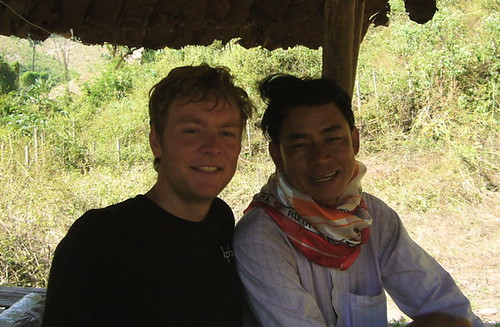
Dtaw introduced us to Jatoo, our guide for the trip. Jatoo is originally from a Karen hill tribe village far in the north of Thailand closer to Chiang Rai and the border with Burma. Jatoo speaks several languages including Thai, English and many of the hill tribe dialects.
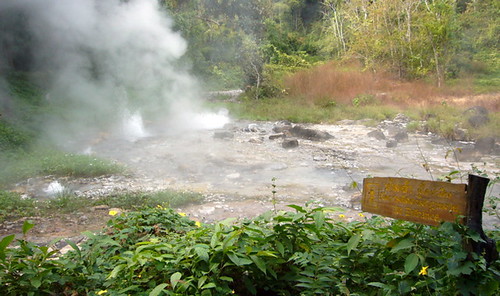
We began the trek at a Thai National Park and wildlife preserve that features a geyser geothermal area. Jatoo had told us that we would start the trek at a hot springs. We left Chiang Mai in the morning and drove for a few hours to begin the hiking around noon. It was getting on to the hottest part of the day and I knew we had many miles of steep climbing ahead through jungle into the mountain provinces, so I was not all that excited to start the trip at a hot springs. A few weeks ago when I was high in the mountains of Idaho and the wind was cold and the sky was pregnant with snow clouds I welcomed the opportunity to soak in hot springs. But in tropical Thailand? A hot spring dip seemed a bit unwelcome.
So you can imagine my surprise, and relief, when I saw jets of boiling water shooting into the air. Of course we wouldn’t be expected to soak in this – when Jatoo had said hot spring he had meant really really hot spring. “Like Yellowstone,” he said. Indeed.
This centipede is nearly 1 foot long, and poisonous.
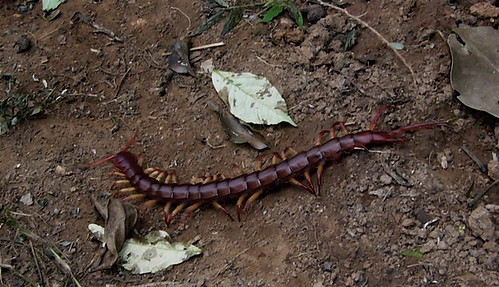
A termite mound.

A very large spider...
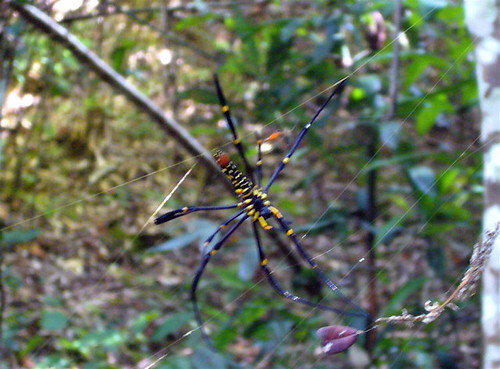
After visiting the geysers we hiked deep into the jungle. Jatoo pointed out all sorts of interesting plants, trees and insects along the way. We arrived in time for dinner at a Karen hill tribe village. The buildings here are made of wood and bamboo, with thatch roofs. Several of the houses had solar cells with batteries and one or two fluorescent bulbs for lighting. These were given to the hill tribes by the government if the tribes promised not to engage in the opium trade.
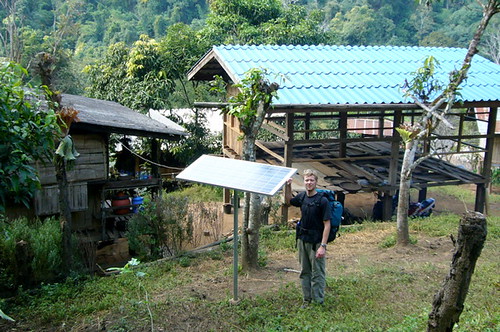
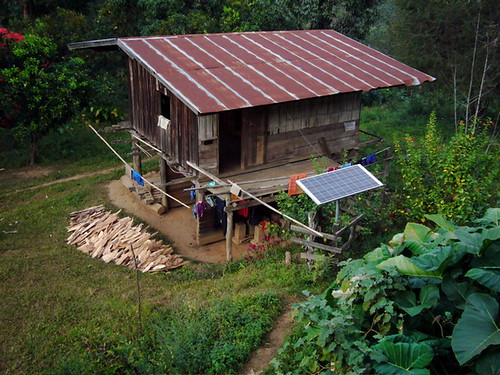
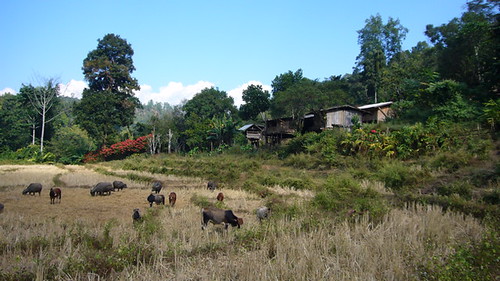
The hill tribes of northern Thailand are one of the last remaining examples in the world of genuine subsistence living. This particular tribe provides for over 80% of its needs from its small farm and the surrounding jungle. The Karen village we stayed in cannot be reached by car -- only recently have they acquired a motorbike, which mainly the young boys use to go into the tiny town several miles away for socializing.
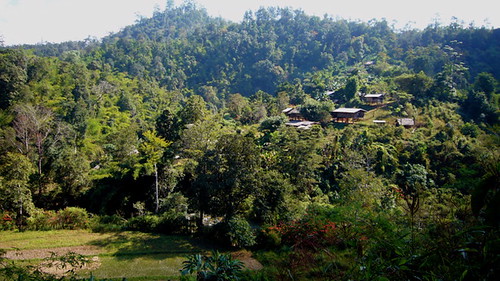
Many of the tribes in the area are so small – consisting of only a few families – that the government will provide for only one school for several villages. Sometimes the children hike five or ten miles to school, and stay over many nights during the week.
Where we slept at the Karen village. The mosquito nets were unnecessary since it is the dry season. We slept on thin padded mattresses that were quite comfortable, and were awakened (early!) by the roosters.
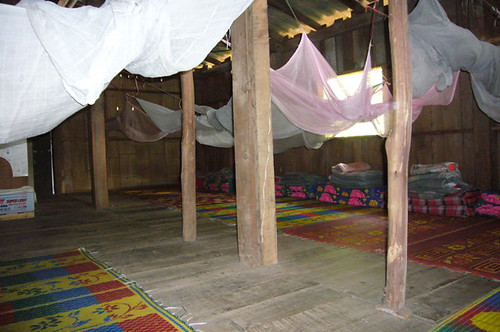
Although the villages we visited are very “poor” in our sense of the word, the quality of life is not bad, if it is rather hard-scrabble. Diets consist of rice and vegetable as well as meat from chickens, pigs, cows and water buffalos – they thought we were a bit odd for being vegetarian. Also they eat wild rodents like squirrels and field mice, as well as deer and other wild mammals that inhabit the jungles.
Water buffaloes.
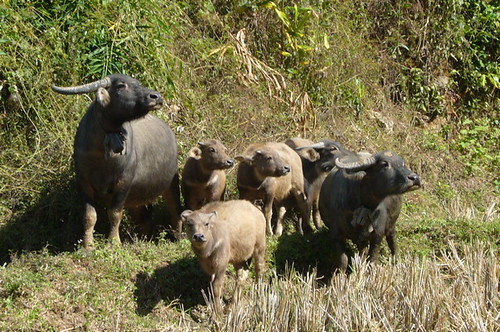
One Karen villager demonstrated an ingenious field mouse trap for me. It was made of a short (about 6 inches long) section of bamboo, which is hollow, with a long piece of stiff reed attached resembling a bow. A loop of twine is concealed in the hollow of the bamboo, and a catch mechanism holds the reed bow in a taut bent position. The trap is loaded with a bit of rice; when the mouse goes to eat the rice it trips the catch and the bow snaps the loop of twine around the mouse’s head and it’s caught. It’s probably hard for you to imagine the device from this description, but I assure you it’s very clever.
Banana trees of several varieties proliferate wildly in the village and surrounding jungle, as well as dragon fruit, mangoes, star-apples and papayas. We saw gardens growing many types of beans, peppers and all sorts of herbs and spices for cooking such as lemon grass and basil.
On the second day we hiked long across two steep mountain ridges and arrived mid-afternoon at an elephant camp along the Mae Taeng river. Our tough hiking through the hot jungle was rewarded with a lazy ride down the river on the back of an elephant to our destination for the evening: a Lahu hill tribe village. No motor vehicles of any kind can reach this village – transportation is only via foot trail or the river. The Lahus have historically been associated with the opium trade from Burma, and so as “punishment” by the government were given no solar cells. They did not seem the worse for it though.
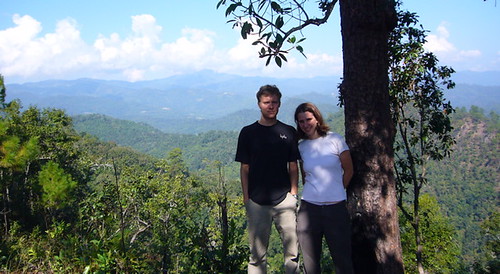
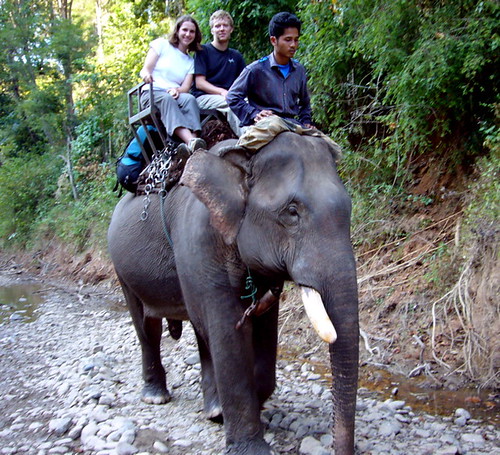
Jatoo says the Lahu are his favorites, since they are so friendly and polite. He mentioned another tribe that has a reputation for being arrogant – the elitists of the hill tribes I suppose. I don’t remember their name, but it’s just as well since I don’t want to be accused libelous speech towards the hill tribes.
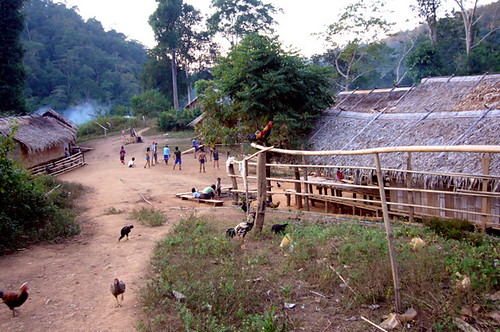
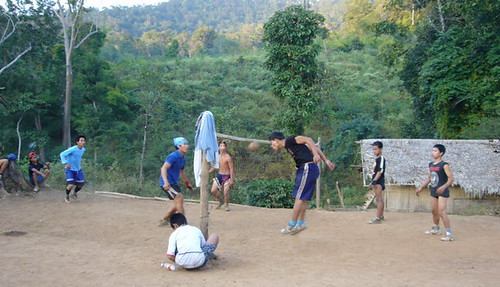
Pictured are some young boys playing the Thai national game – takraw – a kind of volleyball using only the feet and head. They are quite good and as such I can’t understand why Thailand is typically so poor at soccer. All villages have takraw courts installed by the government health department as a campaign to promote exercise.
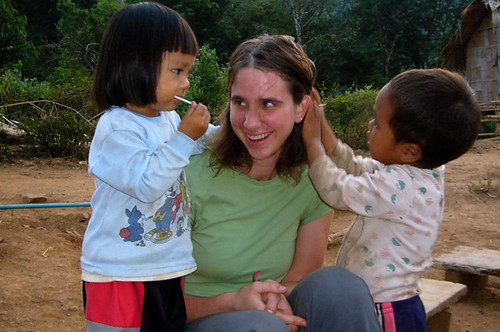
The Lahu children took a real liking to Beth, as you can see here. And I’ve tried to photograph our dinner, but I didn’t do it justice. Jatoo was an excellent cook – even cooking for vegetarians, which he found odd – and the food looked, smelled and tasted superb. We had rice grown in the village paddies, tofu and vegetables in a curry with coconut milk and cashews, as well as an omelete made with fresh green chili paste that Jatoo prepared in a mortar and pestle.
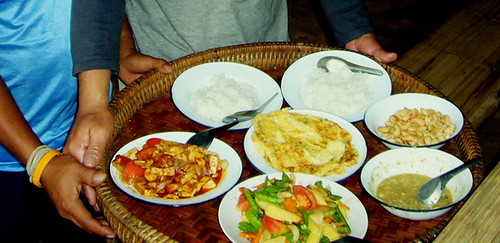
For the final day of the trek we rafted through some mild whitewater rapids on a bamboo raft made by the Lahu villagers. These rafts are about 30 feet long and four feet wide, made of 15 – 20 long thick bamboo poles lashed together with rattan reeds. Near the front of the raft they constructed a tri-pod out of bamboo poles to hold our backpacks up out of the water. As we started down the river, all of the admonitions about standing up in the boat went out the window – there was nowhere to sit and besides we had to stand to use long bamboo poles to guide the raft between rocks and around the many bends of the river.
In the mid-afternoon we reached the pull-out, had lunch, and were picked up by Dtaw and dropped off at his company’s river camp for a snack of coffee, papaya and dragon fruit and to rest a while. His river camp has a few bamboo hut dormitories for overnight treks as well as a kind of cabana hang-out/eating place. It’s all open-air and has a spectacular view of the river below and the rice field and huts of a Thai village along the foothills across the way. It’s basically paradise. We sat in hammocks in the shade and enjoyed the fruit and read Thai travel magazines and conversed for a while. Then Dtaw drove us back to Chiang Mai, with a detour to the Pun Pun farm where I will be living and working this winter.
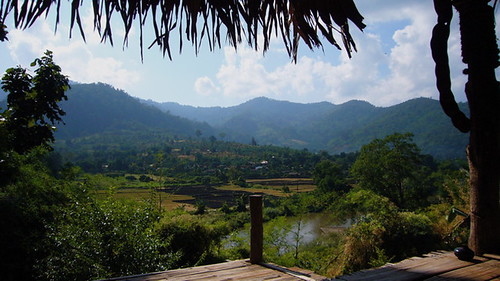
If Dtaw’s river camp was paradise, then Pun Pun is like some kind of upper level of paradise. I got a brief tour and met some of the folks there. I’m leaving Chiang Mai Saturday December 9 to move up there – as I get settled in I’ll take lots of pictures and try to write some descriptions about how wonderful it is. I’m very excited to share it with you!


1 comment:
Wow~~. it looks beautiful.
Post a Comment